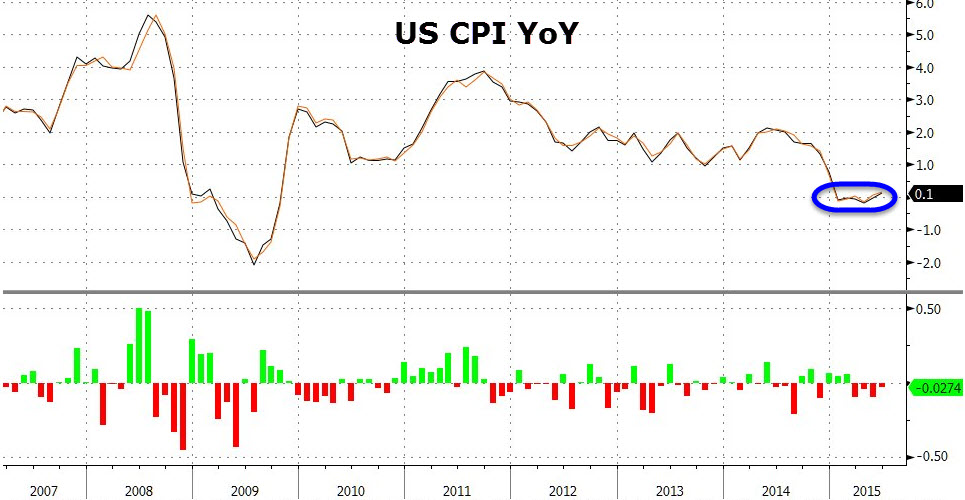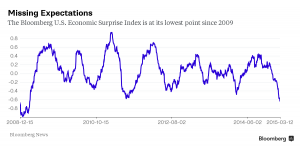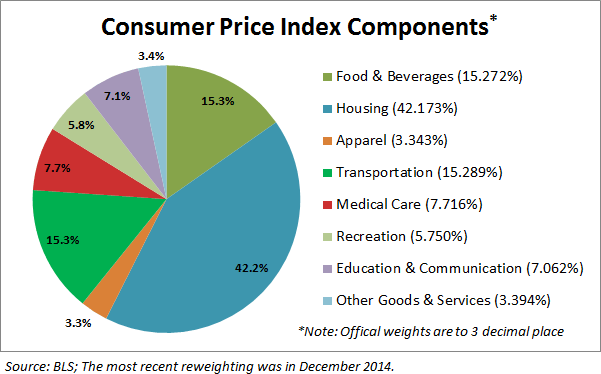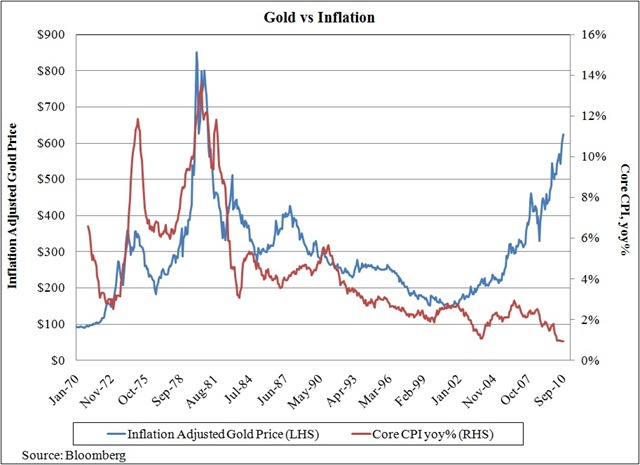by Andrew | Jul 17, 2015 | BLS, CPI, Definitions, In the news, Inflation, Monthly CPI Updates
U.S. consumer prices increased for the fifth consecutive month in June, led higher by a rebounding price of gasoline, although there was nothing in the latest release which should pose any immediate alarm for markets or consumers at large. The latest report from the BLS reported an overall increase in headline inflation of 0.3% month on month – an increase that was inline with nearly all economists polled prior to the announcement. Looking at the headline number on an annualized basis, inflation rose 0.1 percent In the 12 months through June, following an unchanged reading for the month of May.
Gasoline prices rose 3.4% month on month, following a 10.4 percent surge in May. Given the recent volatility in crude oil prices and inventory data in July, there could be scope for the influence of rising gas prices to subside in coming months. Oil is currently trading within the $50-60 / bbl range, well below the levels seen in May and June.

Core CPI, which excludes food and energy related costs, increased 0.2 percent month on month following a rise of 0.1% previously. On an annualized basis, core CPI has now risen 1.8 percent.The June reading continues to highlight just how tame the inflationary environment is within the US economy at present. The strong dollar is helping to keep a lid on inflation by reducing the price of imports and wholesale costs. The strong US dollar has been been spurred partly by a flight to safety due to concerns in Europe and China, and partly by the market’s anticipation of a Fed rate hike later this year. We should expect to start hearing comments regarding the damaging effects of the stronger dollar by Fed officials in the weeks and months ahead should this trend continue.
The food index posts largest increase since September 2014
The price of food increased 0.3% in June, largely to an ongoing shortage in wholesale eggs which has caused a sharp jump in retail egg prices across the nation. Egg prices jumped 18.3% in June, the largest monthly gain since August 1973. Elsewhere, the index for meats, poultry, fish, and eggs rose 1.4 percent in June, with the beef index rising 0.9 percent. Food prices are likely to remain elevated in the coming months as the aftermath of the bird flu epidemic works its way through the supply chain. Wholesale food costs have been consistently increasing in PPI surveys, and these costs are likely to make their way down to the consumer in the weeks and months ahead.
Medical Price Inflation starting to cool off
Medical related inflation cooled in June which will be a welcome deviation from the overall trend in 2015. The price for Medical Care Services fell -0.2% in June and the prices for Medical Care Commodities remained unchanged month on month. Health care costs have been one of the largest contributors to inflation over the past 12 months, with both indices rising 2.3 percent and 3.3 percent respectively.
Rent Prices continue to Climb Higher
The shelter index climbed 0.3% in June, and 3% on an annualized basis as the supply of housing continues to shrink in key regions. Rent increases are also amongst the largest contributors to overall inflation in the United States within the past 12 months.
Outlook for Rates
This month’s CPI data contains no surprises, and the relatively tame reading in the core number on the back of the strong US dollar will likely stick in the minds of Fed officials in the weeks ahead. Globally, sentiment continues to wane dramatically given the continued turmoil in Greece, and increasingly China. While Greece appears to be on the verge of some sort of political settlement, the headline risk remains. In China’s case, there is a very real danger of investor sentiment turning, which could spell disaster for emerging markets overall. Latin American and South East Asian markets look at particular risk, especially on the currency front. The fate of these regions would be sealed in no uncertain terms should the Fed raise rates, and it is for this reason that it appears increasingly unlikely that the Fed will raise by year end, despite all of their rhetoric and expressed intention to do so.
by Andrew | Jul 10, 2015 | In the news, Inflation

Rising tensions within global financial markets were the dominant concerns among Fed officials according to minutes just released from their June policy meeting, leading to yet another delay in the Fed’s widely anticipated normalization of interest rate policy. Uncertainty surrounding the future of Greece and ongoing market weakness in China triggered a cautious tone among most members, although signs of continued strength in the domestic economy, especially the labor and housing markets provided enough signs encouragement for other members to favor a rate hike in the near future.
The tug of war between these two forces will be the dominant theme for Fed watchers going forward, and signs of either beginning to dominate in the weeks ahead should offer some more concrete insight into the timing of the Fed’s next move.
In the Fed’s own words:
“Many participants emphasized that, in order to determine that the criteria for beginning policy normalization had been met, they would need additional information indicating that economic growth was strengthening, that labor market conditions were continuing to improve, and that inflation was moving back toward the Committee’s objective.”
The Fed is essentially adopting a “wait and see” approach before pulling the trigger on a rate hike which might seem premature in hindsight.
The Good – Labor Market Continues to Pick Up
On a positive note, job creation and improved employment prospects according to official figures has buoyed the Fed’s expectations for wage growth to pick up for the rest of the year. Recent consumer confidence surveys echo the Fed’s optimism, with average consumers hopeful of real wage increases in the coming months. Increased wage growth would help boost the domestic economy going forward, and the Fed will likely keep monitoring the retail sales data and employment figures closely in the weeks and months ahead for signs of a solid platform of growth emerging.
The Bad and The Ugly – Greece Weighs on Fed Outlook
Dissecting the June minutes in more detail reveals the Fed’s growing concern about the disruptive influence of overseas market turmoil arriving on domestic shores. Greece clearly weighed on policy makers minds, with particular focus on the contagion “Grexit” would cause for European financial institutions, and the domino effect this could have on US banks.
The Fed didn’t mince any words in this regard.
“[M]any participants expressed concern that a failure of Greece and its official creditors to resolve their differences could result in disruptions in financial markets in the euro area, with possible spillover effects on the United States.”
An important point to note is that the June FOMC policy meeting took place well before the most recent turmoil in Greece really flared up. It’s almost certain that the Fed would be adopting even softer language surrounding Greece given recent events. The Chinese stock market has also imploded in recent weeks, and is likely to overshadow even Greece in the near future as the biggest threat to worldwide economic stability. In recent weeks China has employed a variety of increasingly desperate measures to help slow the stock market decline, but neighboring countries in the Asia Pacific region will be looking on anxiously for signs of contagion in the near future.
Inflation continues to remain below target
On the inflation front, the minutes identified stabilizing oil prices as a potential boost to inflationary pressures within the economy in the coming months. The Fed expects increased energy costs combined with a tightening labor market to help push inflation back towards its target of 2% by the end of year – current levels are well below target.

Summing up the inflation environment and economic picture in the Fed’s own words:
“The information reviewed for the June 16-17 meeting suggested that real gross domestic product (GDP) was increasing moderately in the second quarter after edging down in the first quarter. Labor market conditions improved somewhat further in recent months. Consumer price inflation continued to run below the FOMC’s longer-run objective of 2 percent and was restrained significantly by earlier declines in energy prices and decreases in prices of non-energy imports. Survey measures of longer‑run inflation expectations remained stable, while market-based measures of inflation compensation were still low.”
In summary, it is clear there is growing sense of frustration within the Fed with regards to its inability to start normalizing rates which have been set near zero percent since the onset of the 2008 crisis. With ongoing stress in world financial markets, the Fed knows a premature hike in rates would be enough to send many nations over the edge into a full blown recession. Upcoming domestic data will be key in the coming weeks, should there be a deterioration in the domestic economic picture, then all bets for any form of rate hike this year would certainly be off.
by Ryan Barnes | Mar 25, 2015 | CPI, Definitions, gold, Inflation
The U.S. economy got a little economic boost today with a stronger-than-expected CPI reading for February, and a strong Purchasing Manager’s Index (PMI) that continued to project GDP growth.
Headline CPI and core CPI both came in 0.2% higher than January, as slight price hikes at the pump for refined products balanced out a general breather in the declines in some of the base commodities. The headline numbers had been tracking negative for the past three months, which everyone was pretty much ok with chalking up to crude oil. Just so long as GDP growth came in respectably, there wasn’t any reason to panic.
But core CPI (ex-food and energy costs) was already lagging behind Fed goals of around 2%, and already in the midst of sending deflationary ripples up the global goods chain, into…well, just about everything.
Muddled Waters for First Rate Hike
It’s created a tense chess match between investors and the Fed the past few weeks. It started just after the stellar (as in +295,000) February jobs report last month, when the consensus started to form that the Fed would have to act sooner rather than later in creating a interest rate normalization cycle.
The key first step of that cycle is getting us off the floor of zero percent rates – a stance that doesn’t befit a growing economy and presents what Yellen herself has called an “asymmetrical risk”.
U.S. Definitely Growing…But How Much?
Just as soon as we seemed to have some headway into a summer rate increase, nearly every economic indicator in the U.S. started been printing well below analyst estimates. In fact, the depth of our misses has hit a multi-year high, according to Bloomberg analysis:

In light of this reversal, both investors and the Fed have had to take stock of things. First quarter GDP estimates continue to be ratcheted down – from the 2.5% – 3.0% level I highlighted last month (a number that was freshly lowered at the time) to an average Q1 GDP estimate of about 1.5% today.
Cranky Markets are Volatile Markets
It’s why we’ve seen a spike in volatility around every asset class – fixed income, forex, commodities, and equities have all been bumping around trying to align their compass to the next clear trend line. Would the Fed remove “patient” in the March FOMC meeting? Was September the new June (for the first rate hike)? Was 2015 off the table entirely?
Answering these questions is challenging enough in isolation, but it’s been exacerbated by the stunning rise the the USD index, which alters true price action in commodities and long bonds. The surging U.S. dollar is a de facto rate hike. It lowers the cost of imports dramatically (a deflationary force), and it makes our exports more expensive overseas.
And while the realities of pricier U.S. exports certainly hurt some companies more than others, the simple fact is that close to 50% of the total revenues of the S&P 500 member companies is derived in a currency other than the U.S. dollar.
2014, Part Deux?
It’s quite astonishing how much the first quarter of this year is looking like the first quarter of last year. Tick by tick, indicator by indicator, we seem to be replicating that market environment.
This time last year we were watching interest rates hit new lows, but convinced the party had to end any moment – inflation was coming, and we needed to position ourselves away from fixed income and into equities, gold, and other commodities. Fixed income turned out to deliver stronger returns than even equities did.
GDP looked to be on track for a good start to the year, but then a bout of really bad whether caused us to actually contract as an economy in Q1. Most of the top analysts said “don’t worry, we’ll be strong in the back half of the year”, and sure enough we were. The U.S. turned in over 4.5% growth in the next two quarters.
Looking around today, it’s much the same setup – so far. The key differences between then and now are this:
1) the unemployment rate is lower than last year; we have clearly moved close enough to full unemployment in the Fed’s eyes that it’s no longer an impediment to a rate increase. That box is checked off.
2) the USD is much stronger (10-20% or more) against every major global currency. As I’ve discussed, this move alone is the equivalent of a 25-50 bps rate hike.
In fact, if the dollar hadn’t been zooming so hard the past six months, there’s a chance the Fed would’ve put a token 25bp hike out there last week. Instead, Yellen reminded us that the Fed isn’t there to make things easy for investors, saying the Fed “can’t provide and shouldn’t provide” certainly to markets when it comes to the timing of rate hikes.
We don’t seem to be in any danger of that.
by Andrew | Mar 6, 2015 | BLS, CPI, Inflation
Inflation is one of the most important economic indicators available to consumers and investors as it gives a strong signal how the economy is currently performing, and perhaps more importantly, a strong hint at which way monetary policy is likely to swing in the coming months. The Federal Reserve analyzes inflation trends in detail, and any sign that inflation is getting either too high, or too low will often be met with a swift policy response; usually an increase or decrease in interest rates. Changes in interest rates affect every aspect of the economy including mortgages, student loans, business loans, savings accounts, and government debt.
In light of this, it is crucial that you gain a strong handle on the numerous ways that inflation is measured in order to give yourself an insight into the potential direction of monetary policy at the Federal Reserve, and how such policies are likely to impact you as an individual. Althought we use the CPI for the sake of our calculator, we understand that there are various other ways to calculate inflation and each way has its pros and cons…
Official Government Inflation Measures: CPI and PPI
The Bureau of Labor Statistics has the unenviable task of producing inflation statistics within the United States. They do this by collating a vast series of data from the economy in order to produce two key inflation indicators – namely the Consumer Price Index and the Producer Price Index.
The Consumer Price Index (CPI), is a measure of price changes in a vast array of consumer goods and services. The CPI measures price change in the most popular products and services purchased by American consumers (basket of goods and services). The CPI is often used a reference point for wage adjustment purposes. The CPI is crucial to monitor as it highlights how much the purchasing power of the dollar increases or decreases. This has wide reaching implications throughout the economy.

Producer Price Indexes (PPI) – are a collection of indexes that measure the average change of selling prices by domestic producers of goods and services. PPI is often followed closely by market analysts as an early indicator of changing trends within the economy. Falling producer prices mean businesses are finding it is difficult to sell their products and are often offering heavy discounts. This can lead to potentially deflationary spirals which plunge the while economy into recession.
Official Government statistics are viewed with skepticism by some parts of the investment community – it is believed that the BLS and the Government have an incentive to “massage” the official inflation figures to suit their own economic message or agenda. Often these analysts and market commentators will use alternative indicators in an attempt to cut through any government bias.
Alternative Measures of Inflation
Gold has been an historically important indicator of inflation for thousands of years and is seen by many as the only real form of enduring money. The purchasing power of gold has endured throughout history without exception. In the past two centuries alone, the purchasing power of gold has held up through countless revolutions and two world wars, fiat currencies by contrast, have come and gone several times over! It is unsurprising therefore, that many investors and market commentators will look at the gold price to gain insight into the overall health of an economy. An elevated gold price highlights stress and distrust within the overall financial system, and a distrust with the monetary policy makers in general. Gold prices tend to rise if inflation is expected to increase. Gold overall is a valuable indicator for providing an inflation indicator free of government bias.

Growing distrust of official statistics has also given rise to independent organizations which keep track of their own data to generate inflation forecasts. One such organization is shadowstats.com which aims to cut through bias in government statistics and forecasting to provide a more balanced view of inflation within the economy.
Cover all Bases
As always, the devil is always in the detail. There is no single measure of inflation which you should accurately rely on to make decisions for your business, or investments. Increasing bias in Government statistics make it necessary to look beyond the official figures to gain a more comprehensive picture of what is really happening with regards to inflation. As we have discussed, by mastering all the different ways to monitor inflation, you will be able to make increasingly informed decisions and opinions.
Which measure of inflation do you like to use? Let us know by commenting below.








